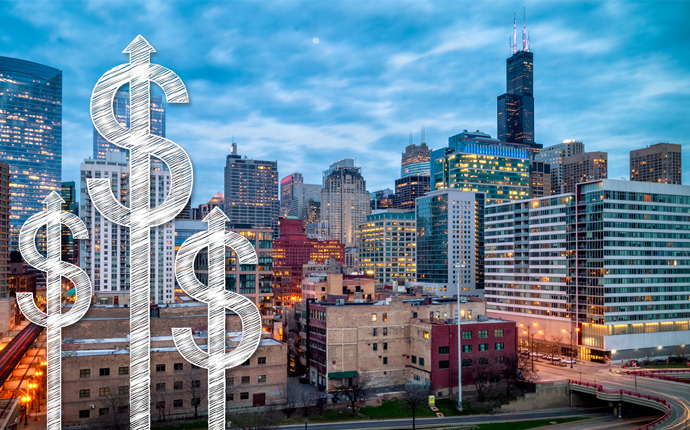Updated July 9, 7:04 p.m. For the first time this year, it costs more on average to rent an office among the converted warehouses of Fulton Market than it does to work in a lakefront high-rise east of the State Street.
The Fulton Market and River West neighborhoods averaged an asking rent below $31 per square foot during the second quarter of 2018, but last quarter the figure surpassed average rents in the East Loop submarket, which have wobbled around $37 for at least a year, according to midyear data released by CBRE.
It was another sign of the ongoing westward shift in demand for office space Downtown, where overall rents notched up by 50 cents to average $40.58 per square foot. The business district’s direct vacancy rate shrank to 11.7 percent, as its total quantity of occupied space grew by almost 460,000 square feet compared to the first three months of the year, according to the report.
Most of that growth was driven by frenzied leasing activity in the West Loop Gate area between Wells Avenue and the Kennedy Expressway, which saw more than 560,000 square feet of positive net absorption, or the net change in occupied space, compared to the first quarter, the report showed. The new tenants forced a quarter-over-quarter plunge in the area’s vacancy rate from 12.6 percent to 11.4 percent, thanks in part to co-working and event-space company Convene signing a 105,000-square-foot lease at 311 West Monroe Street.
Landlords west of the Loop will soon have to compete with a torrent of new office space, as projects like the Old Post Office, Bank of America Tower and BMO Tower come online in the next several years.
“We’re seeing increasing demand for all things new, for buildings with the best infrastructure and the best amenities,” said Kyle Kamin, an executive vice president in CBRE’s Chicago office. “There’s so much competition for labor, and right now it’s about what tenants can do to make the biggest splash going forward.”
New and renovated buildings in the West Loop and Fulton Market are putting a premium on outdoor space and offering tenants the chance to “feel like a big fish in a small pond,” luring them away from other parts of Downtown, Kamin added.
Last quarter, strong leasing activity west of the Loop more than canceled out swelling vacancies in the Central Loop submarket, which saw more than 222,000 square feet in negative net absorption as companies picked up and left the heart of Downtown.
Much of the loss can be traced to the Lasalle Street corridor, which took another hit when the city fleet and facilities management department downsized its offices last month.
And even in Fulton Market, where startups are taking up space near the recently opened offices of Google and McDonald’s, developers might be building workplaces faster than companies can occupy them. The report pointed to the 150,000-square-foot office building completed by McCaffery Interests this quarter, which remains less than half occupied.
The vacancy rate for Fulton Market and River West jumped to nearly 16 percent as its inventory of empty office space ballooned from 388,000 to about 517,000 square feet, according to CBRE. But Kamin cautioned that the vacancy numbers include leased space that has not yet been occupied, meaning that the true amount of unclaimed office space is much lower.
“As I see it, the most demand is in Fulton Market right now,” Kamin said. “This [last quarter] just happens to be a snapshot when there haven’t been a lot of moves there.”
River North, also considered a startup mecca, maintained by far the lowest vacancy rate of all six submarkets last quarter with 8.2 percent. But the rate has steadily climbed from 5.8 percent at the beginning of 2018, and it’s had negative net absorption every quarter since, the data shows.
The section of River North east of State Street, which CBRE calls the North Michigan Avenue submarket, saw its vacancy rate fall from 11.7 percent to 11 percent between the first and second quarter this year.
Technology companies leased about 39 percent of all Downtown office space at the beginning of this year, while financial firms leased 34 percent, according to CBRE. “Business services” firms ranked a distant third with 7 percent of space leased.
Editor’s note: This article was updated to include comments from CBRE’s Kyle Kamin.
